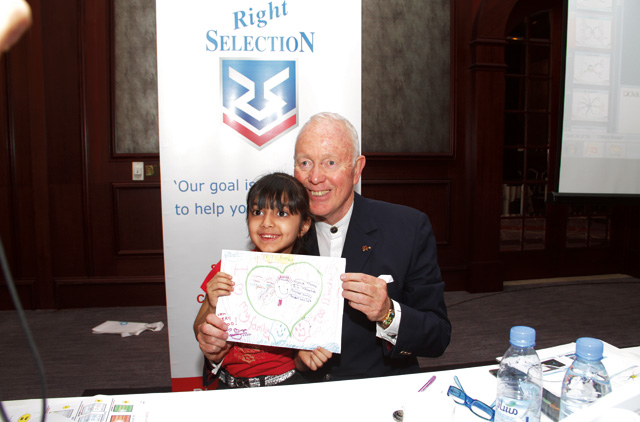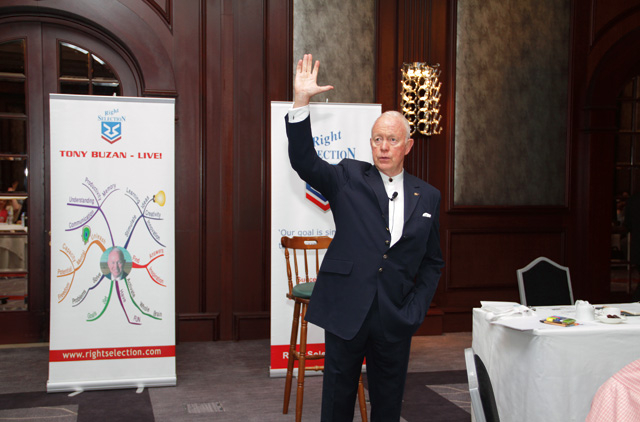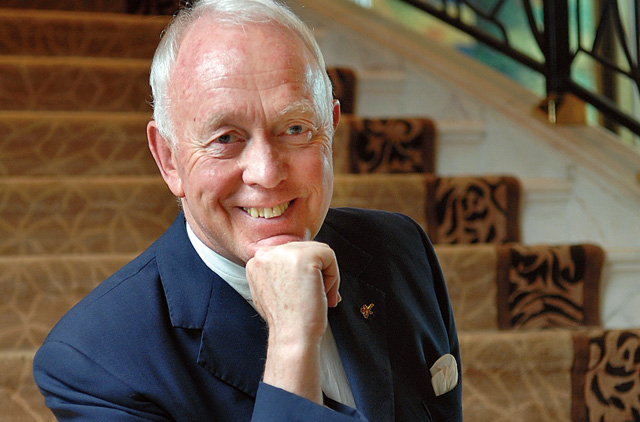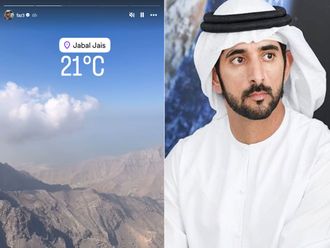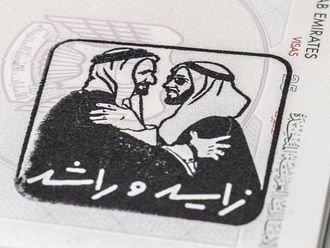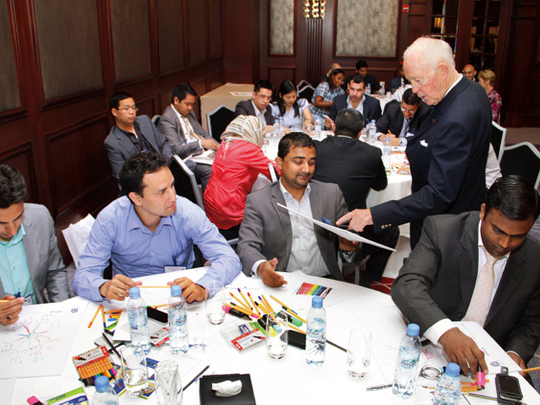
I decide to begin my interview with Tony Buzan with a tricky question.
"Do you remember the first book you wrote?" I ask him.
When a mind-mapping guru has written 122 books ("and counting"), is 69 years old, caught up in a whirlwind tour of the UAE, in between meetings with the organisers of the Emirates Airline Festival of Literature to discuss his next appearance for the event, among many other things, it is likely that such a question would make him pause, even if just for a second.
But Buzan doesn't. Instead he shoots back, "Yes, I do. My first effort was a tiny little book about my pets when I was eight years old. As a very small boy, my passion was nature and I had pets - cats, a dog and a bunny rabbit and I wrote a very small book called My Pets, filled with their photographs and a discussion about my pets and how much I loved them… That was my first book."
It's my turn to pause, but Buzan's forging ahead.
"In 1971, when I was 29, I wrote my first volume of poetry. I am a poet and I have published four books of my poems. But 1973 was the big launch with what you can call my first international book, Use Your Head, which is now in its 50th printing - a new edition. That is the book that was used in the television series of the same name. It was the global introduction to the brain and mind map.
"I can remember every one of my books," he says, looking at me with an expectant gleam in his eye that seems to challenge me to come up with another memory test. I don't — with him, I realise, it's best to accept he is probably up to every single question you put to him.
Use Your Head was the book that gave birth to all his other books, "including the mind-map book, and each one of them gave birth to other books," he says.
"For example, in Use Your Head there was a chapter on memory that gave birth to the memory book, and the chapter on speed reading gave birth to the speed-reading book. Another chapter on mind maps gave birth to the mind-map book, which in turn led to three mind-maps-for-kids books, a book on mind maps for business, one on mind maps at work, and on and on it goes. You know, I used to think that when I finished a book, I was finished with it. But it's like a wonderful Hydra. Every time a head disappears, more heads appear, so I will be writing for the rest of my life. The more books I write, the more books I find that I still have to write about. I use it like an inspiration and that's wonderful."
He has a simple explanation of why such abundance of thought is possible.
"The more you travel, the more you meet people, the more you have to write about," he says. And then comes a grand confession that ideally ought to have been at the very end of the interview, "Actually I have to stop myself from writing!"
But that's typical of Buzan. He offers youa wealth of information which he puts out at double the speed of a computer.
Early start
Buzan got the idea of mind maps "when I was very young".
He explains that he realised even at that stage that people have different levels and layers of intelligence.
Young Buzan's interest was not only in animals, but also in people who were labelled ‘different' or ‘stupid'.
"All children are much more intelligent than they are told they are or the school thinks they are; they just have different intelligences," he explains.
"One of my best friends in school was a boy who could identify flying creatures by their flight patterns. He could distinguish all kinds of birds just by flight. I couldn't, but I was considered very bright and intelligent, whereas he was considered dull and stupid and not able to concentrate."
That was the point when Buzan began to question common perceptions of intelligence. Later experiences were to prove him right, for example when he was at university:
"I began taking more notes. The more notes I took, the fewer marks I scored. I thought, ‘that doesn't make sense,' so I examined my note-taking techniques. I realised that the notes were all words in one colour and one colour is a monochrome, which is a monotone which is monotonous. Monotonous is boring, and what does your brain do when it's bored? It switches off, shuts down, goes to sleep. So I had been training myself to switch off, shut down and go to sleep and I was doing a good job of it. I was sleeping in the library, and so were half the students as well!"
So, Buzan set off on a quest to measure the power of the brain and find out the true nature of intelligence and over the next few years he worked on what he would later call ‘mind maps'.
"It has been assumed that we think with words," explains Buzan. "The fact is that while on a second level we think with words, primarily we think with images, associations and the senses."
Imagine this
He suggests an experiment to demonstrate his point. "I am going to give you a piece of data and I am going to check how long it takes you to access that data and [whether there are] any associations or connections with what your brain accesses. Ready? The piece of datais ‘mango'."
He looks at me and says, "How long did it take? An instant? From an infinite database your brain accessed it in an instant and you have never heard it before, not with this accent, this ambience and associated noise, and yet your brain accessed it just like that. If you can explain how you did it, you will get a Nobel Prize! No one knows how we do it, but the fact that we can do it means that a normal human brain is far superior to any super-computer. Now, when you accessed it, what happened?"
I tell him an image of a mango appeared in my mind.
"Any associations with it?" he asks.
"Taste, my childhood memories," I reply. "Childhood memories, taste, colour…so that's how we think," he says.
"We don't think with words. We think with images and the associations that radiate from those trigger images."
He then says, "OK, let's take another fruit, an apple. If I say to you ‘manzana' - blank. If I say to you ‘ping guo' - blank. If I say ‘pomme' - again blank. All I have been saying to you is ‘apple' - in Spanish, in Chinese, and in French. All those words are designed to do the same thing: if it's a sound you know and the brain hears it and knows what the association is, that image will appear on the brain. Doesn't matter what language it is. So, the language is a sub-routine. A mind map is based on the way the human brain thinks and it thinks with images that radiate out. It's like the map of a city or the tentacles of an octopus. Main thoughts and second-level thoughts radiate from that. Like the chapter headings of a book. The third level radiates from that, and so on, all radiating out like sun beams."
He goes on to make a sample mind map.
"Let's say you are asked to give a speech on - or write a thesis on - Dubai. You would [map] Dubai on the middle of the page, then think what the main themes would be. Put people on a branch, and on sub-branches radiating from them would be the different nationalities, with the numbers and percentages of those people in Dubai. On another main branch you would put in climate or meteorology, which would lead to the four seasons and what happens in those seasons. Culture would be another main branch radiating off the central image; you would have literature, and under that head you would have poetry, novels, essays, and so on. Theatre, art, and the like would be another branch. [There would be] a branch for business and all the offshoots from that; a different branch for history, one for media, and so it goes on.
"As that mind map builds and branches out, you could easily write an article or a PhD thesis on that. ‘In this essay, I am going to introduce you to an extraordinary country called Dubai. There are nine main themes I would discuss and they include the following: the people, the culture, the environment, the history, the media, the business and so on.' Based on this overview, you would say Dubai is fascinating for the multiplicity of the races and nationalities of its people… So, a mind map is an externalised visualisation of your thinking process."
Growing success
Buzan soon realised the efficacy of mind maps for teaching children. "I started teaching children in schools and I realised that they were not only not being taught to think, they were being taught how not to think. So I showed a few children how to mind map and they really took to it.
"Encouraged, I showed it to my friends and some of them started to use it. Then my mum started to use it - when she was 50 - and went to university for the first time in her life, and she used it to get a first-class master's degree. That was the first degree she'd done. She convinced the authorities that she wasn't ‘old' at the age of 50, and that she could study for a master's degree without a bachelor's degree in hand. Obviously, they were a bit apprehensive, but she got a first-class degree using mind maps."
Mind maps gained greater publicity in 1973, when Buzan was approached by the BBC, which wanted to do a programme about them. "It's now used by more than half a billion people across the globe in schools for teaching, note-taking and exam preparation, and it has been developed with key words, more colour, images and codes and has been translated to the computer," says Buzan.
Having got the key, the next thing was to use it to open doors of opportunity.
"One of the major aims was to apply this techniqueto students with learning difficulties, people with dyslexia and autism. Mind maps have helped quite dramatically in all those areasof learning disabilities."
Now, mindmaps have taken on a new guise with advances in technology. "We have iMindMap software to make it 3-D. In future, the applications are just going to multiply."
"Let me tell you a story," says Buzan. "I was invited by Andrew Hurt, the managing director of Xerox Emirates, who said the purpose of the invitation was to present me with a surprise. It was something to do with mind mapping…I went to their new office and, driving there,I saw in the distance a building that looked a bit like a Xerox machine and Andrew said it was their new headquarters. He said it was conceived using a mind map. He had looked at what a building needed to be to make all the people working in it to feel productive, creative, happy and flexible - in short, have all the aspects of the brain cells stimulated. He had conceived it on one big mind map. Andrew then gave the mind map to the architects and said, ‘this is what the building has to be'.
"So, this morning I saw the first building in the world to be conceived with a single mind map. The building is exactly what he wanted, and when I went in I saw what he saw. There are colours to stimulate [the brain]. The space is very ergonomic; the work places make you want to work there. It is all very simple, beautifully organised. When they began building it people had told him it was too far away, none of the employees would move in there. However, every single employee stayed and [they] were so happy with the building.
"Now, the interesting part is his11-year-old daughter uses mind maps too. He told me that when she found out that she was going on a holiday she mind-mapped everything she needed. So, there you are - mind mapping is applicable for anything that requires thinking. From building an entire new headquarters for a multinational corporation to an 11-year-old girl mind-mapping what she needs on her holiday!"
Wider application
What started off as a memory tool is now growing into "this Hydra which helps you plan, helps solve problems, helps you market, negotiate, deal with personal problems, helps children plan their holidays, helps children get As rather than Ds, and the applications just keep multiplying," says Buzan.
Take any profession or any area of study and there are now people mind mapping it. "Google ‘mind map' and a 107 million results pop up!" enthuses Buzan, "Click mind map images and you get another 40 million images of mind maps."
Buzan can't resist one more success story as the interview draws to an end.
"One of the most powerful women in the banking world at the moment is Dr Zeti Akhtar Aziz, the governor of the Central Bank of Malaysia," he says.
"She designed the whole future of the bank on one mind map. It is now consistently ranked the top central bank in the world. She consistently wins awards and prizes. She was recently named Malaysia's Woman of the Year, because she has trained herself and her staff to think."
With so much done, what keeps him going? "The brain has multiple intelligences which can be tapped into and developed and trained," he replies, with no trace of pomposity.
"My life's goal is a mentally literate planet in which every single child knows about his/her brain, knows about his/her physical nature, structure and power, and recognises his/her cognitive skills. At the moment we are at the evolutionary turning point where the world is beginning to focus on the brain, the mind and the spirit, the capacity of which is much greater than everybody thought. So, it's a hopeful future."
By the way...
Creative minds make links others don't think of or see right away. Having the freedom to create links that don't follow any type of logical order - and to do it visually - is at the heart of the mind-mapping approach.
"When people discover mind maps it is like an epiphany, like reinventing themselves," says Tony Buzan.
"It is like you have been driving through your life with mud and sand caked on the windshield and suddenly the wipers swish and then its all clear. Mind maps allow you to think and when you discover them, you are not discovering a tool or a technique, but discovering yourself, your potential. It's very comforting, and a wonderful compliment to yourself."
Inside Info
Buzan's latest version of mind maps is available at www.thinkbuzan.com Download the trial application and you get the basic iMindMap5 for free.


